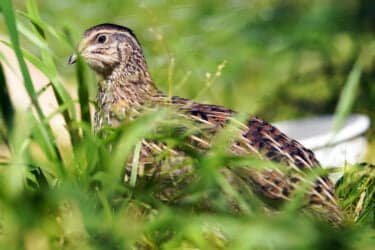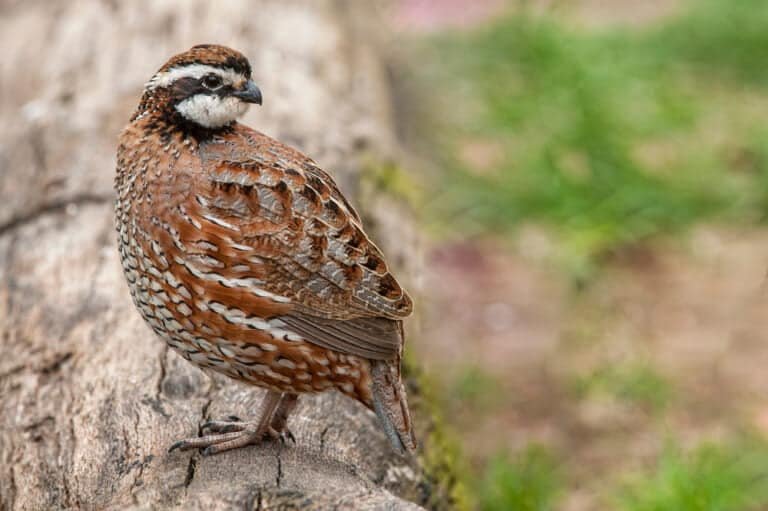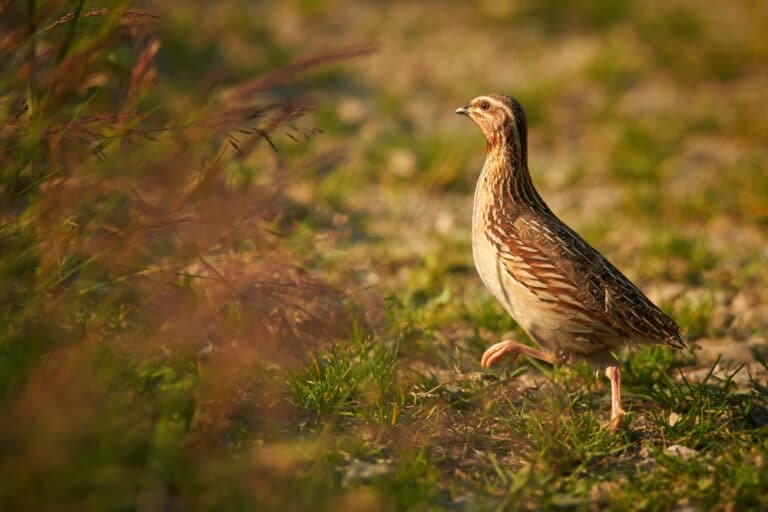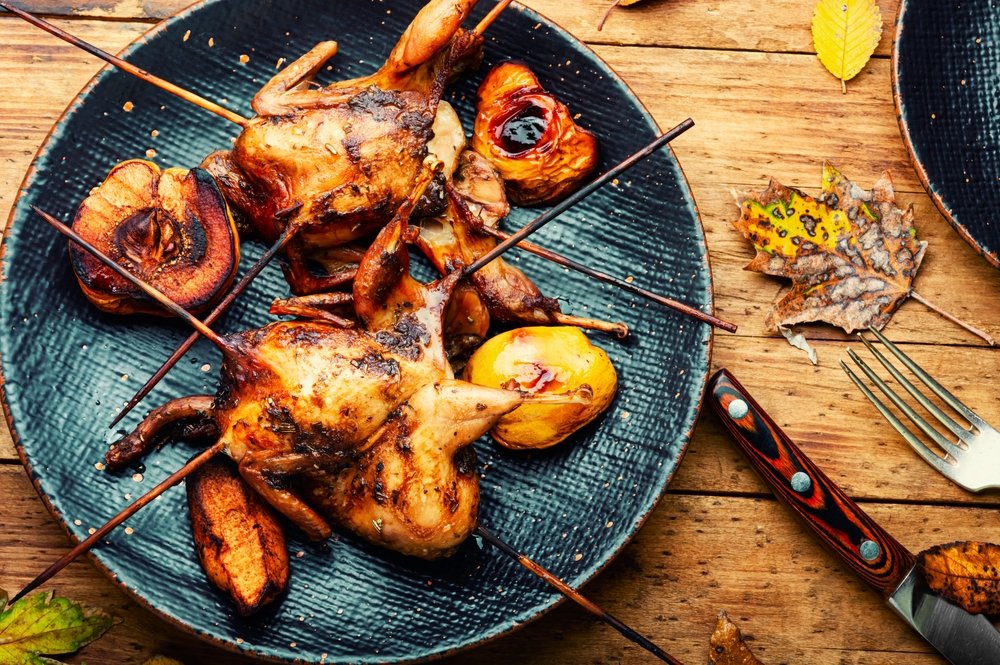The Coturnix Quail: A Fascinating Bird of Paradise 2025
Coturnix quail, scientifically known as Coturnix coturnix japonica, are small ground-dwelling birds that belong to the Phasianidae family. These dainty avian creatures have captured the hearts of many enthusiasts and farmers alike due to their numerous appealing qualities.
Coturnix quail has established a prominent place in domestic and commercial settings with its delightful appearance, chirping, and remarkable adaptability.
Definition and Overview of Coturnix Quail
Coturnix quail is a small game bird originating from East Asia but is now found worldwide. These birds typically measure about 6-8 inches long and weigh around 4-6 ounces. They sport an array of distinctive color variations such as tuxedo (black and white), golden speckled, silver speckled, and more.
Their compact bodies feature plump chests, short wings designed for swift flight over short distances, and sturdy legs suitable for running. These charming birds possess a delightful nature—friendly yet somewhat timid—and exhibit fascinating social behaviors when raised in groups or pairs.
Additionally, they display remarkable adaptability to various environments and can tolerate various climatic conditions. Due to these attributes, Coturnix quail has become a beloved pet for aviculturists or individuals seeking low-maintenance companionship with unique feathery friends.
Importance and Popularity of Coturnix Quail
The importance of Coturnix quail lies not only in their aesthetic appeal but also in their practical value across different sectors. These birds play a crucial role in the agricultural industry as they efficiently consume insects harmful to crops while providing natural fertilizer through their droppings.
Consequently, farmers and gardeners often introduce Coturnix quail to their fields and gardens to maintain ecological balance and promote healthy plant growth. Furthermore, Coturnix Quail has gained significant popularity for its meat and eggs.
The meat of these birds is tender, succulent, and highly nutritious, making it a desirable choice for culinary enthusiasts. Their eggs, although small compared to chicken eggs, have a rich flavor that appeals to various palates.
Quail eggs are often sought after by gourmands and are utilized in haute cuisine due to their delicate taste and ornamental appeal. Coturnix quail’s small size lends them well to compact living spaces such as urban backyards or apartments.
For individuals restricted by limited land or local regulations prohibiting larger poultry species, these charming birds offer an opportunity for avian companionship without compromise. Their ease of care, relatively low maintenance requirements, and melodious vocalizations make them an ideal pet choice for those seeking the joy of bird-keeping within confined environments.
Taxonomy and Classification
Scientific name: Coturnix coturnix japonica
Coturnix quail, scientifically known as Coturnix coturnix japonica, belongs to the animal kingdom, phylum Chordata, class Aves (birds), order Galliformes (game birds), family Phasianidae (pheasants and allies), genus Coturnix, and species coturnix. The subspecies name “japonica” refers to their origin in Japan. This classification places them within a diverse group of avian species with various characteristics and behaviors.
The genus Coturnix comprises several species of Old World quail known for their small size, distinctive plumage patterns, and rapid wing movements. Among these species, Coturnix coturnix is recognized as the most widespread and extensively studied due to its adaptability in various habitats.
Kingdom, Phylum, Class, Order, Family, Genus, and Species of Coturnix quail
Coturnix quail are classified as follows:
Kingdom: Animalia
They belong to the animal kingdom since they possess complex multicellular organisms.
Phylum: Chordata
-As chordates, they exhibit a notochord during embryonic development and possess a hollow nerve cord along their back. – Class: Aves – Being birds means they have feathers for insulation and flight adaptations such as lightweight bones.
Order: Galliformes
This order encompasses ground-dwelling birds characterized by strong legs suitable for terrestrial locomotion. – Family: Phasianidae – The pheasant family includes various game birds known for their colorful plumage patterns.
Genus: Coturnix
Quail of the genus Coturnix share characteristics like small body size and a combination of camouflage and vibrant plumage. – Species: Coturnix coturnix – The specific species name, coturnix, refers to the common quail found in Europe, Asia, and Africa.
Understanding the taxonomy and classification of Coturnix quail provides a framework for studying their evolutionary relationships and ecological roles within their broader avian family. This knowledge enhances our understanding of their unique characteristics and contributes to their conservation efforts.
Physical Characteristics
Size and Weight
Coturnix quail, scientifically known as Coturnix coturnix japonica, are small-sized birds with an average length of about 6-8 inches (15-20 cm) from beak to tail. They stand approximately 4-5 inches (10-12 cm).
Regarding weight, adult quail usually range between 4.5 to 6 ounces (130-170 grams), with males slightly heavier than females. These compact dimensions make them agile and swift in flight, enabling them to navigate through dense vegetation easily.
Plumage
One of the most fascinating aspects of Coturnix quail is their diverse range of color variations within their plumage. While the wild-type variety exhibits a predominantly brownish hue with intricate black-and-white markings, selective breeding has resulted in various color mutations.
These variations include but are not limited to colors such as white, silver, golden, tuxedo (a combination of black and white), cinnamon, red, orange, and even blue. The plumage patterns can also differ significantly among individuals due to genetic factors and selective breeding efforts.
This variability adds aesthetic appeal and assists in camouflage within their natural habitats. Quail with lighter colors tend to blend into grassy environments more effectively.
Beak, Eyes, Legs, Wingspan
Coturnix quail possess several distinct features contributing to their survival in the wild, starting with their beaks, which are short and sturdy structures designed for efficient feeding on seeds and insects found in their environment. Their eyes are positioned on either side of their head,d providing them with excellent peripheral vision crucial for detecting potential predators or locating suitable food sources.
Their legs are strong and equipped for both terrestrial movement and flight. Quails have relatively long legs compared to their body size, allowing them to sprint rapidly on the ground to escape threats swiftly.
Additionally, their wingspan spans about 9-11 inches (23-28 cm), enabling them to take flight quickly when necessary. These physical attributes collectively make Coturnixquitel adaptable creatures, capable of thriving in various environments while remaining agile and vigilant against potential dangers they may encounter in the wild.
Natural Habitat Preferences
In the Grassy Meadows
Coturnix quail are known to favor grasslands as their primary habitat. These open areas with abundant low-lying vegetation provide an ideal environment for these ground-dwelling birds.
The grasses offer ample cover, making hiding from predators and observing their surroundings easier. Their small size allows them to navigate through the dense grass effortlessly, allowing them to forage on seeds, insects, and other small invertebrates that thrive in such habitats.
Within Agricultural Fields
Another favored habitat for Coturnix quail is agricultural fields. These birds have adapted well to human-altered landscapes and can often be found amidst crops such as grain fields, cornfields, and even vegetable gardens.
Abundant food sources within these cultivated areas attract the quail, who find an array of seeds and insects readily available. However, it’s worth noting that certain pesticides or intensive farming practices can hurt their population.
Seeking Shelter in Forests with Dense Undergrowth
While Coturnix quail is primarily associated with open habitats like grasslands and agricultural fields, they also seek shelter within forests with dense undergrowth. These woodlands protect from predators while offering varied food sources,s including fallen fruits, berries, and a diverse range of insects found among decaying plant matter. Quails take advantage of this unique ecosystem by utilizing the understory as a refuge and a foraging ground.
Geographic Distribution
Coturnix Quail Around the World
Coturnix quail has established populations on every continent except Antarctica due to their adaptability and resilience in various climates. They are most commonly found in regions across Europe, Asia, Africa, and North America.
Countries like France, Italy, and the United Kingdom house substantial populations of these birds in Europe. Asian countries such as China, Japan, and India also host large Coturnix quail.
North American Presence
In North America, Coturnix quail has been successfully introduced to many states,s including California, Texas, Florida, and Georgia. Their adaptability to diverse habitats has allowed them to flourish in these regions. Their presence provides recreational hunting opportunities and contributes to the delicate balance of local ecosystems.
Thriving in the African Wilderness
Africa boasts a rich diversity of Coturnix quail species across its vast landscapes. From the savannas of Kenya to the grasslands of South Africa and the deserts of Namibia, these birds have adapted well to survive in challenging conditions. Their ability to locate food sources even in arid environments showcases their remarkable resilience.
By understanding their natural habitat preferences and geographic distribution worldwide, we can appreciate how Coturnix quail have adapted and thrived across various ecosystems. This knowledge enhances our understanding of these fascinating birds and allows us to prioritize conservation efforts necessary for preserving their habitats and ensuring their continued existence for future generations.
Behavior and Social Structure
Diurnal or Nocturnal Behavior Patterns
Coturnix quail are primarily diurnal creatures, meaning they are most active during the day. They are known to start their day shortly after sunrise when they begin foraging for food. During this time, they display heightened activity levels, searching the ground for seeds, insects, and small vertebrates that make up their preferred diet.
As the day progresses, coturnix quail engages in various behaviors such as dust bathing, preening their feathers, and socializing with other members. While diurnal tendencies dominate coturnix quail’s behavior patterns, it is important to note that they can also exhibit some nocturnal activity.
In particular, when daytime temperatures become excessively high or predation risks increase, quail may shift some of their activities to dusk or dawn hours when conditions are more favorable. This flexibility allows them to adapt and balance survival needs and environmental challenges.
Foraging Habits
Regarding foraging habits, coturnix quail display remarkable versatility and opportunism in their diet. Seeds constitute a significant portion of their nutrition intake; they avidly consume various seeds from grasses and plants in their natural habitat.
These resourceful birds also feed on insects such as beetles, crickets, grasshoppers, caterpillars, and spiders. The diverse diet of coturnix quail includes small vertebrates like lizards and snakes, if available.
Their ability to adapt to different environments allows them to exploit food sources in agriculture fields or areas adjacent to forests where seeds (such as grains) are abundant due to human cultivation practices. This adaptability has contributed significantly to their success as a species by expanding the range of habitats in which they can thrive.
Mating Rituals and Courtship Displays
Coturnix quail engage in elaborate mating rituals and courtship displays during the breeding season. Males, known as cocks, are particularly active during this period as they compete for the attention of females or hens. These courtship displays often involve exaggerated behaviors aimed at impressing the females and asserting dominance over rival males.
The male quail may puff his chest out, fan his tail feathers, and bob his head while emitting distinctive clucking or crowing sounds to attract a mate. Additionally, he may engage in “tidbitting,” where he presents food to the female as an offering.
This behavior demonstrates his ability to provide and reinforces the bond between potential mates. Females play a more passive role during courtship but ultimately choose their mate based on various factors such as the male’s display quality, physical condition, and overall vigor.
Once paired up with a female, males tend to become territorial and protective of their chosen mate throughout the breeding season. Coturnix quail’s behavior and social structure exhibit fascinating intricacies contributing to their survival strategies and reproductive success within their ecological niche.
Reproduction and Life Cycle
Egg-laying process: frequency of laying eggs per female quail
Coturnix quail are known for their prolific egg-laying capabilities. A single female quail can lay an impressive number of eggs throughout her reproductive life. A healthy and well-nourished adult Coturnix quail can lay up to 300 eggs annually. However, this number can vary depending on age, health, diet, and environmental conditions.
Younger females initially tend to have lower egg production rates but gradually increase as they mature. The laying frequency of Coturnix quail is influenced by the photoperiod or the duration of daylight hours.
Maintaining a consistent light cycle becomes crucial for optimal egg production as these birds are highly sensitive to day length changes. In commercial settings or controlled environments, artificial lighting systems regulate the photoperiod and stimulate continuous laying.
Incubation period: duration required for eggs to hatch
Once the female Coturnix quail lays the eggs, they must be either incubated naturally by a broody hen or artificially in an incubator to ensure proper development. The incubation usually lasts around 17 to 18 days before the chicks begin hatching. Maintaining optimal temperature and humidity levels during incubation is critical for successful embryonic growth.
During natural incubation by a broody hen or within an incubator, it is essential to rotate the eggs regularly to prevent any complications caused by improper positioning within the shell. This rotation helps ensure that each embryo receives adequate nutrition and oxygen during development.
Chick development stages: from hatching to maturity
The life cycle of Coturnix quail chicks involves several distinct stages, each marked by significant changes in their development. Upon hatching, quail chicks are covered in soft down feathers and have well-developed legs that enable them to stand and move shortly after birth.
Their eyes are open, allowing them to explore their surroundings with curiosity. In the first few weeks, the coturnix quail chicks require a warm and protected brooding environment to maintain their body temperature.
Feeding on a specialized protein-rich diet is crucial during this stage to support rapid growth and development. As they age, they gradually transition into a diet comprising grains, seeds, insects, and other small invertebrates.
Around 6-8 weeks of age, the juvenile quail start to resemble adult birds in terms of their appearance but are not sexually mature yet. It takes approximately 8-10 weeks for Coturnix quail chicks to reach full maturity and develop reproductive capabilities.
Male plumage becomes more pronounced at this stage while females attain their adult size. The life expectancy of Coturnix quail ranges from 2 to five years, depending on various factors such as genetics, diet quality, predator avoidance skills, and overall health maintenance.
Domestication and Uses
History of Domestication
The history of domestication of coturnix quail is a fascinating journey that dates back thousands of years. It is believed that the ancient Japanese, Chinese, and Romans were among the first cultures to recognize the potential benefits of keeping these birds as livestock. Ancient texts and archaeological evidence suggest that coturnix quail were initially domesticated for their meat and eggs as early as 12,000 BC. Over time, various civilizations across Asia, Europe, and the Americas embraced their domestication due to their adaptability in different climatic conditions.
Popular Uses
Coturnix quail has become increasingly popular in various industries due to their numerous practical uses. One primary utilization is for meat production. These small birds provide a lean source of protein with a delicate flavor that appeals to many culinary enthusiasts. Quail meat is highly valued for its tenderness and versatility in gourmet cuisines worldwide.
Another popular use of coturnix quail is egg production. Although relatively small compared to chicken eggs, quail eggs are packed with nutrition and are highly sought after by health-conscious consumers.
Their unique speckled appearance adds an aesthetic appeal when used in culinary presentations or enjoyed independently. Beyond food-related purposes, Coturnix quail have gained popularity as pets due to their small size, low maintenance requirements, and appealing personalities.
Many bird enthusiasts choose these delightful creatures for companionship or ornamental purposes within aviaries or backyard enclosures. Additionally, coturnix quail is significant in research endeavors across various scientific disciplines such as biology, physiology, genetics, behavior studies, and more.
Their rapid reproductive cycle makes them ideal subjects for studying reproductive biology or conducting experiments related to genetic trait inheritance. , Coturnixx quail have been domesticated for millennia and have proven to be versatile animals with multiple applications. From their historical significance as a food source in ancient cultures to their modern-day utilization in meat and egg production, as pets, and as valuable subjects of scientific research, the coturnix quail continues to captivate our attention and serve diverse purposes today.
Breeding Techniques
Artificial Incubation
Breeding Coturnix quail can be achieved through various techniques, and one popular method is artificial incubation. This method involves collecting the quail eggs and placing them in an incubator, which provides the necessary environmental conditions for successful development. The eggs’ temperature, humidity, and turning must be carefully regulated to mimic the natural incubation process.
Typically, a temperature range of 37-38 degrees Celsius (99-100 degrees Fahrenheit) and a humidity level of around 60% are maintained. Turning the eggs several times a day ensures proper oxygen distribution within the egg and prevents adhesion.
Natural Incubation
Breeders may opt for natural incubation methods where quail parents can hatch their eggs—providing suitable nesting areas with appropriate materials, such as straw or grass.
The female quail will lay a clutch of eggs and incubate them by sitting on them for approximately 17-18 days until they hatch. During this period, providing a calm environment with minimal disturbances is crucial to avoid disrupting the natural incubation process.
Selective Breeding
Selective breeding plays a significant role in enhancing desired traits among Coturnix quail populations. This technique involves choosing individuals with desirable characteristics such as larger size, improved health, or prolific egg-laying capabilities as breeding stock. By consistently selecting these individuals over several generations, breeders can gradually improve these traits within their quail populations.

Conclusion
Coturnix quail breeding techniques encompass artificial and natural methods depending on breeder preference and available resources. Whether utilizing artificial or natural incubation methods or implementing selective breeding programs, successful reproduction requires careful attention to temperature, humidity, and egg turning.
By employing these techniques, breeders can ensure the growth and development of healthy quail populations. The beauty of breeding Coturnix quail lies in the rewarding experience of witnessing new life emerge from carefully nurtured eggs and contributing to the sustainability and diversity of these remarkable birds.






